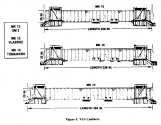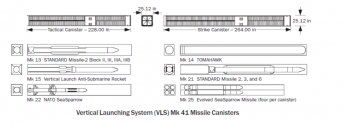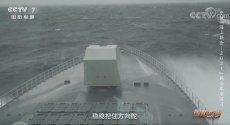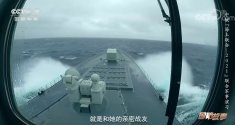I recall writings that the Ticos had too many VLS to actually be used, which is why the Arleigh Burkes only have 96 VLS cells.
But if it makes you feel better, the Type-055 VLS cells are twice the size of the Mk41 VLS on the KDX and Ticos.
That is based on 85x85cm and a depth of 9m, versus the Mk41 at 61x61cm and 7m depth
In order to be clear, its like this. Mk. 41 is said to be around 6.8 meters and 7.7 meters in length, but its the canister sizes that matter. Here we have 25" or .635 meters in diameter with 5.8 meters in length for one canister and 6.7 meters in length for another. Note that there is an extra meter of separation between the canister length and the physical VLS length = 5.8 meter canister length to 6.8 meter VLS length and 6.7 meter canister length to 7.7 meter VLS length. This separation should be for the exhaust transfer channel beneath the canister that routs the gas to the central plenum.


U-VLS has two lengths, with a diameter of .85 meters. The first length is 7 meters and the second length is 9 meters. Now this is likely to be canister length, not physical VLS length. The shorter length is for HQ-9 launching and the second length is for YJ-18 launching. Given that the advertised length of the HQ-9 is about 6.8 meters, the canister containing it should be at least 7 meters allowable for missile space not counting cold launch compress gas battle, so the physical length of the shorter U-VLS should be around 8 meters. I estimated from the length of the YJ-18 to be around 8.2 to 8.5 meters, with the missile allowable to be a maximum of 9 meters, and the entire canister length to be around 10 meters to allow for the hot launch channel. This is because U-VLS is a CCL, and the launch system is therefore integrated into the bottom of the canister itself whereas in the Mk. 41, the bottom of the canister outputs to transfer channel.
Burke and Tico should be a mix of both 5.8 and 6.7 meter canister lengths in an undetermined amount. The shorter one is for SM-2 and ESSM and the longer one for Tomahawks and SM-6.
The 052D is likely Bank 1 and 2 = 7 meters, Bank 3 and 4 = 9 meters, rear Bank 5 to 8 = 7 meters. The two rear banks at the bow are capable of firing YJ-18s, 16 of which. The rest fires HQ-9. While the purpose of this VLS is currently air defense, a 7 meter deep VLS remains respectable and is capable of firing a future VLS launched cruise missile in the future.
The 055 might be all 9 meters because we have seen YJ-18s being fired at the rear VLS. Unless it is raised above the main deck level, which is not in this case here, the rear VLS also has to be over machinery space which constrains its depth, which explains why many smaller ships like frigates for instance, don't have rear VLS, and why the 052D's rear VLS should be HQ-9 only. The front VLS banks are ahead of the machinery space in the ship which usually starts around where under the superstructure is. This area towards the bow is the deeper part of the ship which explains why the longer U-VLS is located in front of the superstructure but behind the foremost front VLS.
But given the 055 has 9 meter VLS without a raised main deck at the rear is pretty impressive, and this suggests to me that every one of the 112 VLS on the ship is a ginormous 9 meters in length. If you put that in Russian terms, that means each VLS is capable of firing a Kalibr or an Onix, and that means the ship has an antiship killing capacity that easily exceeds Slavas and even the Kirovs.
To put it short, a ship capable of firing 112 YJ-18/Kalibr/Klub/Onix sized missiles is pretty dope.




